Character | Notes |
 | The "Smiling soldier with a red cap" was modelled by Jan Ciągliński, a teacher of drawing in Petersburg and an active participant in the World of Art movement. He was of Polish ancestry. |
 | The "Tall smiling man", who portrays Andriy, the younger son of Taras Bulba, is the son of the Russian aristocrat Varvara Uexküll von Gyllenband, and the great-nephew of the composer Mikhail Glinka. |
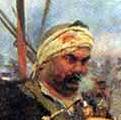 | A tall cossack with a headband on his head is Odesa painter Nikolai Kuznetsov, an ethnic Greek. He was a joker, a strongman, an academician of the Academy of Arts, professor, a class director of battle painting in the Academy. |
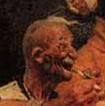 | The toothless and wrinkled old man with a tobacco pipe was captured by Repin from a casual trip companion who accompanied him to a pier in the city of Alexandrovsk (today Zaporizhzhia). |
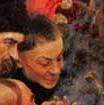 | The student with his hair cut in the Makitra fashion and who is too young to be able to grow a mustache is Porfyrii Martynovych. He studied at the Academy of Arts, was skilled in filigree artwork, "and spent his summer vacations in the Poltava region collecting ethnographic materials and painting or drawing village scenes and portraits of peasants, landlords, stewards, and precentors", [9] as well as "landscapes and portraits." [9] However, due to an illness he was forced to give up landscape painting at the age of 25. Repin was not able to paint him live, but instead used a gypsum mask of Martynovych's face, which captured his smiling expression. |
 | The "Serious Cossack" was modelled by the art patron Vasyl Tarnovsky, an important supporter of Ukrainian culture. |
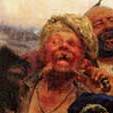 | The image of Cossack Holota ("impoverished") was modeled from a coachman of Vasyl Tarnovsky Mykytka. Repin, who was impressed by the man's edentulous, cyclopic face and drunken, ridiculous behaviour, was able to draw him as he and Mykytka were crossing the Dnieper on ferry. |
 | "The Smiling Soldier", in the role of Otaman Ivan Sirko, was modeled by General Mikhail Dragomirov, an officer in the Russian army and Governor-General of Southwestern Krai. |
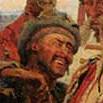 | The character that depicts a Tatar was drawn from an actual Tatar student. |
 | "Taras Bulba", the leader of the Cossacks, was modelled by Alexander Ivanovich Rubets, a professor at Petersburg University. His likeness has been associated, through an entirely incidental process, with the Iranian Azerbaijani folk figure "Hassan Guli." |
 | The "Cossack with a yellow hat", almost hidden by Taras Bulba, was modelled by Fyodor Stravinsky, an opera singer with the Mariinsky Theatre, of Polish descent, and the father of the composer Igor Stravinsky. |
 | The "Top of a bald head" belongs to Georgi Alekseyev, who was Grand Chamberlain at the court of the Russian Emperor, in charge of court finances. He was invited to pose for the role, but refused, as he felt it was undignified. Instead, Repin sketched the back of his head while Alekseyev was engaged in looking at an exhibit of prints. When he saw the painting, Alekseyev recognized his head, and was not pleased, but by then the painting was in the imperial collection. [7] [8] |
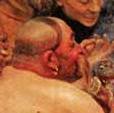 | The half-naked Zaporizhia warrior was a friend of Repin and Yavornytsky and a teacher at the folk school of Kostiantyn Belonovsky. Although he is depicted playing cards, in real life he did not. |
 | "The writer" was modelled by the historian and archeologist Dmytro Yavornytsky, the author of a major work on the history of Zaporozhian Cossacks. |

















